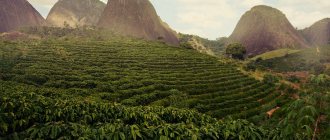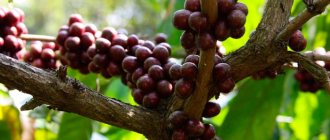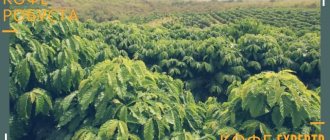Chocolate is almost a gourmet treat, and coffee has the taste of hope. Geoffrey Lindsay
Ethiopia is considered to be the birthplace of coffee. At least that's where the coffee tree was first discovered growing. Brazil, Colombia and Mexico are the three leading countries in coffee production today. But other countries are also actively involved in cultivating their own varieties and participating in the export of “coffee” products. For example, India is famous for its original varieties. Its percentage share in the coffee trade on the world market is about 4%, which accounts for 80% of the exports of all coffee produced in the country. All tasters, tasting the magical drink from India, agree that Indian coffee beans are very juicy, aromatic and have a slight sourness.
Historical reference
The coffee beans from which the first trees grew were brought to the country by a pilgrim who stole them in Yemen. Despite the threat to his life, he did it. Fortunately, everything ended well for him. The trees also grew and began to bear fruit. This story dates back to the early 17th century.
Indian coffee accounts for about 4.5% of the world's total. In the country itself, production is distributed among states as follows: 71% - Karnataka, 21% - Kerala, 5% - Tamil Nadu. In total, the Indian coffee industry employs about 250 thousand producers, 98% of them are private entrepreneurs running small farms. Almost 80% of Indian coffee is exported to Germany, Russia, Spain, Belgium, Slovenia, USA, Japan, Greece, the Netherlands, France, and Turkey. Almost 30% of all exports end up in Italy.
Arabica was the first and only variety grown here. But the story of coffee rust has made its own adjustments. Planters began to cultivate robusta, which was very disease-resistant.
2/3 of the total local harvest is exported to the world market. Which is grown and harvested, for the most part, on small private plantations (read about plantation coffee).
Legend
Indians tell a legend about seven green beans, from which the country's coffee industry grew. For this we need to thank a certain wanderer named Baba Budan, who, having violated all prohibitions, dared to secretly carry coffee seeds across borders and continents.
On the one hand, it was a very brave act, and on the other, it was a crime. After all, in the distant 17th century there was only one state that had a coffee monopoly - Yemen. Coffee could be purchased there in any form, except for fresh beans, which could be sprouted. A strict taboo was imposed on the export of seeds and seedlings from the country.
So honor and praise to the brave pilgrim, because if it weren’t for him, who knows where the history of coffee would have turned. Indians planted Yemeni seeds in the hilly lands of Karnataka. The area where the Indian dynasty of coffee varieties was born is called the Bababudan Hills - Bababudangiris. Now it supplies 2/3 of the country's coffee harvest.
Statistics and facts
- India ranks third in Asia and fifth in the world in coffee exports, sixth in the world in its production.
- There are at least 13 unique coffee varieties grown in India.
- The country is constantly conducting economic programs to support local producers, research is underway, and the coffee industry is more focused on quality than quantity.
- India is one of the 25 most biodiverse countries with a unique climate and nature that has no analogues.
The Mystery of the Seven Seeds
The history of the origin of Indian coffee is hidden behind numerous legends and tales. The most plausible of them is based on the story of the pilgrimage of the Sufi Muslim Hazrat Shah Jamer Allah Mazarabi, popularly known as Baba Budan. According to folk legend, as a true believer, he saw the salvation of his soul in pilgrimages to sacred places. Once, having gone to Mecca to perform prayer rituals, he saw an interesting feature - in the morning hours, his fellow Sufis drank some mysterious drink that gave them vigor and strength to perform prayer. Having tried it, the Muslim was so delighted with the coffee that he decided to bring it back to his homeland, India. How he took coffee beans out of the country is still unknown, but everyone knows one thing - there were seven coffee beans.
Indian Arabica varieties
The main burden of coffee production falls on the southern part of the country, which today produces about 90% of the total harvest. In recent years, India has become known as a supplier of very high-quality robusta, which is actively used in various mixes and blends. Let us remind you that they are the ones who are used to prepare the most popular espresso and its variations.
Indian Arabica is still highly valued by coffee lovers. The ranking of the most popular varieties includes the following.
- Plantation A. It grows in the southern highlands and has a very high strength, especially for Arabica beans. Coffee of this variety has a delicate aroma, with distinct chocolate notes, a dense, strong, slightly tart taste with low acidity. The bouquet contains notes of spices. Often used in blends to add softness to the drink. However, lovers of strong Arabica coffee appreciate it in its pure form.
- Karnataka . The name of this Indian state is well known to lovers of good coffee. Karnataka is where most of the Indian Arabica coffee is grown. The variety of the same name has a mild taste with traditional sourness and a persistent aroma. Medium density, light aftertaste with notes of spices and citruses have many fans.
- Mysore Nuggets Extra Bold . One of the best Indian varieties, can safely be considered elite. The grains are large, bluish-green, smooth and oily. They are processed wet, so they are often called washed Arabica. The finished drink has a delicate taste, bright sourness, and medium density. There is often a spicy note of spice, especially in the aftertaste.
- Mayson. A variety of highland Arabica, which is grown at an altitude of 1.5 thousand meters above sea level. The grains are processed manually, using a dry method. The highlight of this coffee is its dense, bright taste, which does not contain any foreign inclusions and a persistent thick aroma. We can say that this is the purest Indian Arabica of excellent quality.
Plantation A
Plantation A grows in the southern regions of India. This coffee has a bitter taste, although very pleasant. As for the aroma, it is quite soft, reminiscent of chocolate. In some cases, you can hear hints of Indian spices such as cardamom, cloves and pepper in the aroma of this variety. Most often, Plantation A is mixed with soft varieties, then the drink turns out to be pleasant to the taste and not such a strong infusion.
Indian coffee blends
As we already know, Arabica is not the only coffee lover alive in the modern world. The Indian example shows the potential of Robusta in new varieties.
- Robusta Kaapi Royal . A distinctive feature is large grains with pointed ends. Coffee with a dense structure, pleasant taste. Pleasant taste of chocolate, delicate aroma, and unobtrusive taste. This is why they love this variety.
- Kaveri . An example of a cross between Arabica and Robusta. The variety is characterized by high yield and increased resistance to traditional coffee diseases, including the notorious rust. Therefore, it is very popular among farmers. The finished drink has a smooth, rather strong taste, with an oily, spicy aftertaste. The variety is used both for preparing blends and independently.
- Kent . The variety was once famous for its resistance to rust. It was created on the basis of the legendary Typica. Today it is not grown as much as a couple of decades ago, which is a pity. Coffee made from these beans has a pleasant soft taste, delicate aroma with chocolate notes.
- S795 . Another hybrid that now has an impressive share in Indian exports. It is good both on its own and in blends; it is especially loved by Europeans for its light taste, delicate aroma, and chocolate notes. The peculiarity of the variety is that it quite clearly resembles the famous Yemeni mocha, with its characteristic shades of cocoa and chocolate.
Coffee from India: what makes it unique
Coffee trees in India are planted and grown in accordance with technologies that are characteristic of the country's agricultural industry as a whole. The traditions of cultivating land and caring for trees are based entirely on manual labor. The secrets of caring for trees and ensuring optimal climate conditions are passed on by farmers from father to son. Continuity ensures the highest qualifications of the people who work on Indian coffee plantations and provide other countries around the world with high-quality coffee beans.
Most of the coffee beans grown in India are exported to the Russian Federation, as well as:
- to Germany;
- to Spain;
- to Belgium;
- to Japan;
- To France.
About a third of exported coffee is purchased by Italians.
Grown in India, coffee is characterized by a delicate honey flavor with a subtle hint of sour notes. Elite coffee varieties have a bright and rich aroma, while cheaper varieties have a less expressive taste, without a characteristic tart aftertaste.
Coffee heritage of India - Malabar Monsoon
By and large, this is not even a variety, but a certain method of processing coffee beans. Historically, this was the name given to the Arabica variety. But this is not true.
Let's figure out what Monsooned coffee is?
Monsoon coffee is still a separate category of product from India. Only today “sea processing” is carried out artificially, and the process is called “monsooning”. The technology is used on the Malabar coast of the Indian Ocean, where the climate in coastal areas is very humid. During the summer months, the coffee beans are stored in open areas, then packed into canvas bags and infused with the sea “spirit”, resulting in Monsooned Malabar coffee.
But over time, sailboats were replaced by more technologically advanced ships. Coffee began to be transported much faster, in holds that were reliably protected from external influences. The grains have lost their main feature. And at the same time, popularity among Europeans.
Indian planters urgently needed to solve this problem. And they began to artificially create monsoon coffee.
On the Hindustan Peninsula, where the Malabar coast is located, the grains are spread near the ocean, where they are blown by ocean winds for several days. Then they are packaged in bags in which they are stored for 2-3 months, also ensuring access to moisture and air. After two months the product is ready.
Production Features
India (like Ceylon) is primarily a “tea” country; coffee does not bring the main income to the state treasury, as in Brazil or Colombia, but India still has some achievements in this field.
In 2007, the country produced 262,000 tons of grains. As mentioned, 97% of all coffee is grown in three southern states: Karnataka, Kerala and Tamil Nadu.
India is the only country in the world where coffee is grown under two-tiered canopies formed by the crowns of evergreen trees, and coffee in these “forest plots” is often not the only crop. Spices are often planted literally side by side: cinnamon, cloves, cardamom, nutmeg. Coffee beans absorb spicy aromas, which subsequently affects the taste of the drink.
One of the main problems of the Indian coffee industry is high humidity, which provokes the development of rot and mold, especially the Hemileia vastatrix type.
Two methods are used to process coffee cherries:
- Dry – the grains are dried in the sun and then the pulp is removed.
- Wet – the pulp is removed immediately using water and fermentation.
Indian coffee recipe
Indians like to brew coffee in the Vietnamese style, in a special “dripping” filter that is installed directly on the cup.
The filling consists of 70-80% finely ground coffee beans, and 20-30% chicory. 1-2 teaspoons of powder are poured into the filter and 150 ml of boiling water is poured, sometimes the mass is also “crushed” with a special small disk with holes.
The brewed coffee is poured into a dabarah - a traditional Indian vessel for coffee - hot milk and sugar are added to taste, and poured into a tumbler glass and back several times, raising the stream high - this way the liquid is thoroughly mixed, cooled and saturated with oxygen.
Sweetish Indian coffee goes well with desserts, chocolate-covered nuts, and chocolate cookies.
There are numerous coffee plantations in India. High-quality robusta and arabica are grown in this country. Knowing the main characteristics of each variety, everyone can choose the appropriate variety.
Maximus
What is good about Maximus instant coffee (India, soft pack, 70 g)? This is a delicious natural drink made from selected varieties of Indian Arabica. Thanks to the specifics of coffee growing in India, it has a slight sourness, a rich aroma and a soft, balanced taste.
The current freeze drying method of sublimation allows you to preserve the natural rich taste and aroma of roasted beans. That is why chemical flavorings are not used in production.
Maximus coffee is easy to transport and prepare, so you can take it with you outdoors, on a trip or to work. It is packaged in a lightweight, convenient bag with a reusable zip fastener, which has a special internal coating that does not allow other odors and moisture to pass through. The packaging has a colorful design, so this brand stands out among similar products on the shelf.











